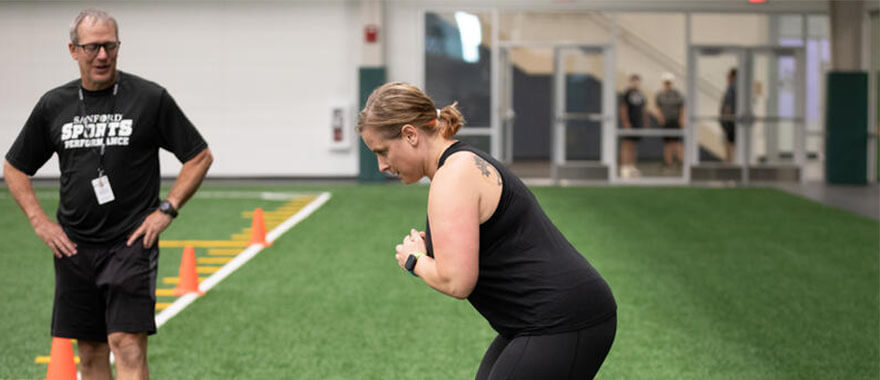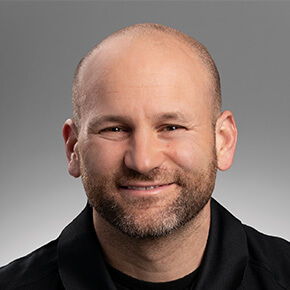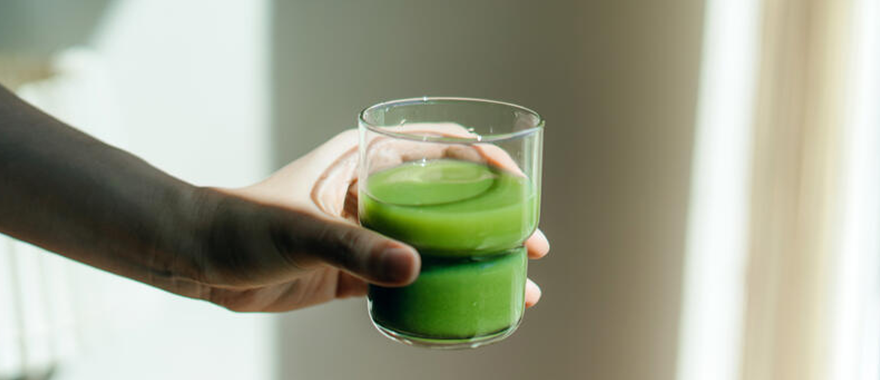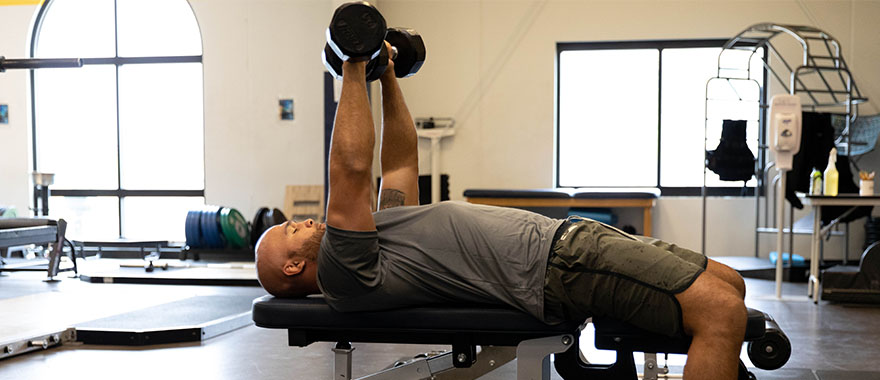Fight your body's 'decay code' with daily movement

Posted: May 6, 2025
Anthony Morando:
I think with exercise, even with movement, you want to constantly try to reduce inflammation. Life is inflamed. Life is inflammation, mentally and physically. When we move, when we exercise, when we have that emotional commitment to something, well-being, we feel better.
Cassie Alvine (announcer):
This is the “Health and Wellness” podcast brought to you by Sanford Health. The conversation today is about movement and the basics of how to get moving for your health. Our guest is Anthony Morando with Sanford Sports Performance. Our host is Alan Helgeson with Sanford Health News.
Alan Helgeson (host):
Anthony, thank you for joining us here today on the podcast. And I love this topic because it applies to me. I mean, I'm going to take stuff away from this and I do from every podcast we get, but I think there's things that everybody's going to get out of this one.
We're talking about movement and knowing that you work with Sanford Sports and you deal with some of the biggest, brightest stars and people that have the potential to go on to do some of the greatest things and the athletes that you're working with, but you also work with regular people, people that just need to get moving, want to move more, want to move better.
Let's talk about folks that want to just start doing that. So our podcast today is about helping people with a basic nuts and bolts of getting movement. So how can movement look different within the different age groups? Now, we'll break down the age groups, and you can go into some of these different areas as you want to, but we're talking pre-teen for folks that have young kids, teens, those young adults, 20s, 30s, middle age, older adults, seniors. And I'm guessing it's all a little bit different. So that's a pretty wide open question to start. Where you need to jump in, just go ahead and do it.
Anthony Morando (guest):
Yeah, you got it. First off, thanks for having me. I think that the centric point today will be movement, which movement is essential for everyone's health and well-being, no matter what age you are from cradle to grave.
And I think where we start with this is basically just given a range of the ages that we have in our facility at Sanford Health. And we have kids in the fourth grade who are learning how to be better movers through competency, through checklists, through specific exercises that are going to provide that competency through a checklist.
And then you have our high school athletes who are more consciously competent along with the collegiate and professional. But then you have our adults and our general population, and everybody's trying to move. The differences, with the ages, are competency. The differences, with the ages, are sometimes full range of motion. As we get older, as our body gets older, we start fighting that decay process.
And decay might sound negative. I like to call the decay, the tide – the tide's coming. So how do we fight the tide? And the way we fight the tide is through movement, resistance training and conditioning. I think in the general population setting, if somebody has some type of significant difference in movement, chances are they can't go through a full range of motion. And then the pattern could possibly be dysfunctional if there's weight attached to it.
So the first thing we try to do is groove the pattern, see if the pattern can become a little bit more functional. And if it looks pretty good, then maybe they start moving weight through a partial range of motion.
With athletes, it's a little bit different. Chances are with an athlete, if there's some type of limitation or lack of range of motion and a specific pattern, it could be due to an injury. It could be due to some other type of limitation on top of that limitation. So we have to be chief mechanics of movement. Our goal is to use movement, exercise, as our platform to create a better scenario for that individual person.
Alan Helgeson:
So when you and your team are working with somebody that might be in middle school training to be better at that football or baseball level, as opposed to somebody like me just trying to do a little bit better, trying to incorporate some more activity for heart health. Let's talk about what qualifies as a movement and how might that be different with some examples from person to person.
Anthony Morando:
I think with movement, with a younger athlete, a kid, and take it again, take it from that fourth grade age, all the way through a senior in high school, their movement demands, when they're training for specifically a sport or sports, their movement demands differ on a consistent basis. Some days they'll move in a linear fashion. Some days they'll move in a lateral fashion. And then there's some days where they're moving in a multi-directional fashion.
Now, if we're going to link that to a scientific term, they move in a sagittal, a frontal, and a transverse plane. So our intent with all three planes is to create an environment, a climate that is specific to sport. Because sport is played in all three planes unless you're a rower, right? And we don't have many rowers around here in the Dakotas-slash-Minnesota, but you know, there are few sports that are only that one-dimensional plane.
So we train all three planes of biomechanical movement in order to create a stimulus that they can adapt to, whether it's inside the weight room, on the field, on the ice, on the court.
Now those movements include all types of variations, meaning they'll activate their glutes in that plane, they'll dynamically move in that plane, they'll perform plyometrics in that plane. They'll lift weights in that plane, they'll condition in that plane.
The difference with someone like yourself is as we get older, we have to fight that decay code differently because now it's fitness for life. Once you surpass sports, right? Now, the great thing about sports is sports teach that fitness is an important part of life. But then when we're done playing a sport, we still have to be fit. That should be the goal. And those planes change as you get older.
Some adults don't necessarily move in the transverse plane as much as they used to due to a knee injury, you know, so what do you do? Some don't move in a frontal plane because of a hip injury. So what do you do? So those are the differences that start happening when it comes to specific movement patterns.
Alan Helgeson:
Let's talk about walking as good exercise. Tell us about why that's a good thing to do. What can a person try to do to make an impact? And how many steps a day can make a difference?
Anthony Morando:
So right out of the gate, I'll say that 10,000 steps a day is a cheat code for life (laugh), right? If you are getting 10,000 steps a day, it means that you're moving significantly and you're burning at least five (hundred) to 600 calories a day if you do have a wearable, right? And wearables, I'm sure we'll get into that, but it's easy to track.
But movement is life. And fitness – under the fitness umbrella, walking is included in fitness. And I would say that walking is like, you know, it's, it's funny. I have some Chapstick with me right now. Some would call this lip balm. I think walking is a great version of hip and back balm, right? Like, it's soothing. It's therapeutic.
You're outside, you could be inside, but either way, you're moving. And whether you're listening to music or you're moving in just silence, it's a great way to generate at least three new ideas. Simultaneously, you're performing aerobic exercise. Not everybody is capable to walk. There are people out there that have limitations that don't allow them to walk. So what do we do? How do we find a way for them to move and get that same type of hormonal endorphin type of effect that's going to still benefit their body? And there are machines, there are ways to still resist whatever type of mechanism they're using, right? But we have to find a way to move.
Now, walking, again, it's the bedrock of movement. If you can walk, it's a great thing to do every single day. So we'll start with that.
Alan Helgeson:
Great stuff about walking, but let's take that even bigger. Let's talk about the suggested minimum amount of exercise for benefits. And how much exercise a week does that look like?
Anthony Morando:
Yeah, Alan, you, you're going to see the U.S. Department of Health is going to suggest 150 minutes a week. They're going to suggest 30 minutes a day, five days a week. That's what they're going to suggest. I think that, say if I'm the one making the decisions for the country: one, right here we go, yep, I'm the guy for the job, right? I'm going to suggest at least 300 minutes a week. Now, that's not to say that that answer is wrong, that they give, that recommendation is wrong. That's taken into effect that I think we do need to exercise more.
Now, simultaneously, life is busy. People are busy. They can't fit in a half hour some days. My job is to encourage them to fight that human nature. If somebody's able to watch a show for 45 minutes, then you can still watch the show. Watch it on a bike, or watch it on a treadmill. You know, it's significant to understand that if we don't move, we slow down and the tide comes closer. Exercise, moving is the single most important thing you can do. And if you do it for an hour a day, it's 4% of your day.
Alan Helgeson:
Anthony, that should be on a billboard. I love it. But we're going to take it here to the benefits of all this movement. Let's talk about how exercise can work towards our blood pressure. Can you give us a little insight on that?
Anthony Morando:
I think the blood pressure question is pretty simple. I think you have to think of pump efficiency. If we have a pump, and a pump is a contributing factor to a lot of different entities in this world. Our pump allowance happens with exercise. We create a better pump. And if we have a better pump, then there's less pressure on our blood vessels and opportunities for our cardiovascular health just continue to stay open.
We have an open opportunity to be healthier if our blood pressure is lower. And there are three quick ways to lower your blood pressure in the natural remedies:
- A, going back to walking, you can walk every single day. That's going to give you a chance to lower your blood pressure.
- B, strength training. Strength training is another form of lowering your blood pressure.
- And C, putting it all together where I can do a strength training exercise, and then maybe I can walk for 60 seconds on an incline treadmill, go do another strength training exercise. And then maybe I can crawl on the floor for 10 yards. That's another example of aerobic and anaerobic exercise that are combined to decrease blood pressure.
Alan Helgeson:
Making us feel good about the benefits of movement. But Anthony, we're about 10 minutes and change into this podcast. Let's talk to the folks that maybe haven't incorporated movement into their day-to-day routine, or for whatever reason, just start doing things. Life has changed. They haven't found the time or made the time, whatever the reason is. What are those small steps? We could just get started, get the jumper cables out and just get started.
Anthony Morando:
You know, Alan, I think the first step to all of this is we have to connect with people psychologically and emotionally before they take that journey. You know, before they actually say, OK, I'm going to try to become fit. Like everybody has some type of blockage on the reason why they can't or won't do something. And you have to connect and commit. It's easy to get a customer. It's hard to get a client.
And I'm going to emphasize, I'm going to hit on that point because I feel like it's important. It's easy to have a customer – knock, knock, hi, I would like a personal training session for 60 minutes (laugh), right? That's great. And that's a quick transaction. Got a couple bucks in the pocket and life is good, but life becomes better for you and for them through longevity. So connect and commit. That transaction needs to become a transformation.
So that customer, you want that customer to become a client. And the only way to do that is to care about them and is to create a relationship first. And then, they become a client and then they don't leave. And that's simple. That's simple math right there, right? That's the T plus T equals, I don't know what the equals sign is yet, but transformation. How about a T equals a TA transformation equals a transaction. And vice versa. They go hand in hand.
I believe that it doesn't matter where you start. It matters that you keep it up forever because that will work. You can start by walking. You can start by doing five pushups a day, right? You can start by pulling a band apart five times a day. It doesn't matter. What matters is that you do it and then you do it again the next day and then you do it again the day after that, and so on and so on. And then on top of that, why are you doing it? Why are you doing it?
Alan Helgeson:
Well, Anthony, let's get into it here. Let's start naming names. Let's talk about some good forms of movement for beginners, those exercises and certain ones for certain age groups. So let's even break it down here by some of those age groups for fitness levels, and let's even talk about maybe some modifications if we want to get into that a little bit after the fact. But let's go.
Anthony Morando:
Yeah, you got it. What's important to understand when you're classifying exercises in movement patterns? It's important to understand something called the LTAD model – the long-term athletic development model. That was established through the late ‘80s, ‘90s and early 2000s compiled over time.
I think it's important to understand that if I have a fourth through sixth grader or even, you know, Alan, I have four kids, right? They all move constantly. When you have these little kids up until the fourth grade, you're working for suppleness. You are working for coordination. So what are the exercises that you can give somebody at a young age? They can body weight squat. They can learn how to do a hang, right? A lat hang or a hanging pull up. They can learn how to do a pushup. They can learn how to do a TRX row.
We have a lot of our little kids doing TRX rows, which is just suspended handles from a higher surface, and they can pull their body weight up. Body weight, split squatting body weight exercise is done in a real efficient and functional pattern along with sprinting and along with jumping and landing. That's really good for a little kid. And they also get that within their sports.
And then to put the cap on the bottle with the kids, games, small area games, obstacle courses, teaching kids how to play, hang, jump, roll. That's all effective for their motor development and for their overall development as the years go on. As they grow, as they get into that sixth through eighth grade range, Alan, and some of them start hitting puberty, that's when we start introducing load to these patterns, meaning we're going to give them weights. That body weight squat now turns into a possible goblet squat, right?
That pushup turns into a bench press. That lat hang turns into a pull up. Now the exercise is the basic movement patterns that we gave those kids become more demanding. Through high school, they've become more demanding and along with college and professional.
General population adults change due to mileage on the body. Adults still squat. Adults still hinge. They still pull, they still push, they carry things. The only difference now is for an adult client, when they're squatting their squat might not be on their back barbell. We don't load our adults in that axial formation where their skeleton is loaded, where their spine is loaded. Instead, we load them maybe from the bottom and maybe their hips tap a box or their glutes tap a box when they squat. There's all kinds of modifications for an adult to squat because we still need to squat.
For pushups, if somebody is unable to do a pushup from the floor, we'll elevate their hands. If somebody is not doing a pull up due to a shoulder issue, then that pull up turns into a lap pull down. So there are modifications, there are ways, but there are cans versus can'ts for everybody that wants to train. And everybody can train. Every body can train. And I'll almost put the “have to” in there because it's important. Because guess what? It keeps you alive longer.
Alan Helgeson:
Well let's move to some of those basic rules here, Anthony. Someone who's maybe not been very active or getting going into this stuff. You want to be watching out for things, you know, that you want to be careful not to overdo things as you're kind of moving into this stuff and you don't want to go from zero to 10 right away. What are some of those things we should be looking out for?
Anthony Morando:
I think no matter what, strength training, learning how to strength train properly is extremely important. You're going to need to learn how to squat in a functional pattern, performing a upper body push exercise, an upper body pull exercise. And I say hip hinge, RDL is common when I say when hip hinge or deadlift. And I don't say deadlift right away though, because everybody thinks that that's just picking up heavy weight from a floor. Deadlift, meaning you’ve got to pick up a heavy bag of groceries at some point off the ground. So we want to still teach that pattern along with aerobic exercise.
If somebody's just starting out, you don't want to throw them into interval training right away. We have a great group here right now who, it's called the transformation group, where six, seven weeks ago we didn't give them any interval-based training, but now we do because they're six or seven weeks in. But their cardio or their conditioning started off with a brisk walk. There needs to be integrity in the weight room because if there's not, somebody can get hurt. And our first rule, no matter what, is do no harm.
Alan Helgeson:
Next question, Anthony. We know a little internet can be dangerous for everybody involved. So we'll do some looking at different things and then we see terms like intensity, endurance or both. So as we're starting with things like this, people may think they should focus on these things. You tell us as an expert, how do we decide what we should focus on as beginners when we're getting into something like that? How do you make that determination?
Anthony Morando:
Number one, if you're starting anything, it needs to be, the word fragmentation needs to exist. Small fragments over a long period of time. So if you're starting out with fitness, first thing I advise is some type of low level aerobic activity for 30 minutes, along with two to three strength training exercises. That's a 45 minutes to one hour piece of your day. If you're unable to fit that in or fit both in, then maybe that day one would be some type of low level aerobic exercise.
And day two, you focus on more than two to three strength training exercises instead. And then you alternate that. I'm always going to push for six to seven days a week. You can do something every day if you gauge the intensity properly.
Engaging the intensity properly comes down to fragmentation. Leave a little bit of gas in the tank every single day so you can wake up and go back to more the next day. Over time, again, if you keep it up and if you get into a groove, then it becomes good for you because it's something that you're doing on a consistent basis. Consistency is key when it comes to fitness, but it needs to be fragmented.
Now, intensity and endurance and all the training variations and attributions out there, they're different for everybody. That's why it's important to have an assessment.
Alan Helgeson:
Anthony, the next question I want to jump to is that word, the big M word here, “modification.” So I may have taken a tumble down a mountain from skiing and I've had some snowboarding incidents where, you know, I've got some orthopedic issues and there are people out there that have bad knees. They might be overweight, or if you're pregnant, let's talk about modifications. How do we figure these things out?
Anthony Morando:
Modifications are just, they are magic bullets within exercise, right? Like exercise is the magic bullet, right? That's the magic pill that that'll keep your life better and it'll keep you around longer. But the modifications in the magic bullets within the magic bullet. I mean, they really work too. I mean, imagine going to the gym and your shoulder’s killing you, but then all of a sudden a coach could say, oh, wait a minute, wait a minute.
You know what, maybe you shouldn't be pressing this over your head, but I bet you if you do it at 45 degrees, it'll lessen the intensity on the shoulder. And then boom, Alan, all of a sudden you're pressing at 45 degrees and you look at me and you go, whoa. Mind blown. We do that every day.
Alan Helgeson:
What I'd like you to speak just a few seconds about here, the modifications. I think modifications keep a lot of people away because they can't do what they maybe used to be able to do. Or if they feel they're having to do something different than what everybody else does, they feel different about it. Nobody wants to look different from what other people do. That's a big deal. Can you speak a little bit about that?
Anthony Morando:
I appreciate that too. Because that's certainly the other side of the coin while we're talking, right? If we just talked heads, now let's talk tails. It goes back to psychologically connecting with your clients. It goes back to saying, OK, you know what Emily, you're not going to do this because we know this is going to light your knee up. I'm going to, or one of our coaches are going to say to ourselves, due to our experience in education, we don't want the modification to necessarily be easier.
We want it to still be challenging. So we might manipulate the sets and reps for that individual. We might make that individual load, that modification, a little bit more than they would with a normal exercise. We want them to feel probably more challenged. That way they have the sense and feel internally that, OK, this is modified, but this is still really challenging for me.
There's two things that happen. They're either going to be satisfied with that modification or they're going to want to go back to the normal exercise because the modification is too challenged, right? And with the athletes, it's a little bit different because the way I modify an athlete, it's like, OK, here's the deal. If that's hurting, that's fine. I'm not going to try to put you in more pain. But if you're not going to run, then I'm going to give you a low impact exercise or a low impact protocol on this bike, and this bike might be worse than the run. And I bet you four out of seven of them start running again. (Laugh)
You know, that's not that bad. I think I'll take the run and I'm not walking around like a little demon, but simultaneously I'm going to be demanding. Yet I'm going to be fair.
I'm going to give you both sides of that coin. And if you can run, you better run because you're going to take away from the specificity of your sport. But if you can't run, it's not going to be easier. You can see, I can, you know, we flick the switch, right? With an athlete, you're still connecting with the athlete. You are not degrading them in any way. You're giving them an option. It's democratic.
With the adults, it's different. You have to give them something where they're going to want to feel more challenged. So it is just, it's just knowing people, right? It's people. Modifications have to do with people too. Not just you being the expert on the exercise.
Alan Helgeson:
Let's talk about something that we know people hear when they go to their doctor's office and they hear the term, if they haven't been active, that they hear these words. Muscle atrophy. What is it? And can you reverse this?
Anthony Morando:
Muscle atrophy is just decrease in muscle mass. It's decrease in strength. Can you reverse it? Yeah. It's one of those scenarios where we get older. We all have a genetic pool. People lack activity. There's some medications out there, there's injuries out there, there's limitations.
But either way, finding a way to strength train two to three times a week will fight against the atrophy. That atrophy is just another word for the decay code. Daily exercise, emotional commitment, reasonable nutrition, and a real engagement with living will fight against any type of atrophy. It's just going to. I mean that. That's it. And it starts with exercise. It starts with exercise.
So atrophy, defeating the atrophy or working against it to delay it, starts with exercise. Whoever out there is listening. If you feel like, “oh, it's too late to start.” It's never too late to start. It's great if you committed to this before, when you look back, if you're 42 right now and you don't start till you're 60, you don't want to look back and say, you know what? I wish I started with 42. It's a lot harder at 60. That's not going against any 60-year-old out there. That gap, that 18-year gap is a big difference.
You can start today. All you have to do is move. If you don't know what type of movement that is needed for your body, then just walk.
Alan Helgeson:
But let's talk about tracker watches, apps, those kinds of things. What are some of those things that Anthony recommends to people he works with? Or your family comes over for Thanksgiving and they say, oh, Anthony, tell us what's going to help me on the tech side.
Anthony Morando:
The trends of fitness, we always have to be aware of. I think wearables have become a really big deal. Everybody I see is, is chances are they're wearing an Apple watch. I love my Apple watch. I get to track my workouts. I get to track my heart rate. I think wearing an Apple watch is important because you can track your intensity, right? You can track how often you're training. It rewards you and almost gives you this little technological incentive. Like, “good job,” “keep moving,” right?
But some people need to see that or hear that. Some people have never worked out seven days in a row before. Some people have never worked out four out of seven days before. That wearable is going to give you some type of award. It gives you a little medal – it pops up, right? Some people think that's cool.
The wearables are important, I think, for heart rate, especially because heart rate is going to dictate the intensity zone that you're training in. A heart rate monitor in general, a heart rate monitor, keeping track of what your heart is doing, what the pump is doing during your least intense zones and your most intense zones. That's important too.
As for a smartphone or an iPhone, there are several apps. Now, I'll say from a technological standpoint, having some type of online training software app is significant for people because online fitness has become a popular entity throughout the world. It's global. And I'll take one more step above that, and this might not be too technological, but YouTube is still a go-to when it comes to education. Not Instagram, not Facebook, not Twitter. It's YouTube. YouTube still holds strong and there's bad content everywhere. There's good content everywhere. But if you can find the right coaches on YouTube, there are so many videos with great coaches performing exercises.
That would be my answer when it comes to technology in the fitness realm. Now there's probably 19 or 20 more Alan, but just to keep it simple, that would be a baseline.
Alan Helgeson:
Let's get to hydration and water. How important does that play a role in any movement and activity and why?
Anthony Morando:
Water is 75% of our body. So hydration plays an important role for multiple factors. A couple that come right to my head would be vitality. In order to function, in order to live, to sleep well, to move well, to breathe well, you're going to need to be hydrated. While you work out, you're going to need to sweat. If you're dehydrated, then you might not sweat as much as you should be.
The other piece of it too is you need to drink water to feel better. Like you feel good when you drink water. You feel alert when you drink water. The fact that you're hydrated is another version of meaning “I am” right? Like, I am. Just like when you drink your coffee, that stimulant, it gives you a bigger version of “I am.” You feel great when you're doing it, but water's a constant. It's like anything else. It's like exercise that's constant. It needs to happen on a consistent basis because if it doesn't, there are significant health dysfunctions that come with dehydration.
Alan Helgeson:
I've got a friend here that I work with and says, when he's not drinking enough water, you don't feel it necessarily the same day. He can really tell the next day. That's a big thing. You can tell the following day.
Anthony Morando:
Yeah, you'll get a headache, feel fatigued, feel lethargic, you know, you might even have some type of delayed onset muscle soreness. I've heard that in a lot of people who are frequently dehydrated and believe it or not, people have trouble drinking water.
Alan Helgeson:
Anthony, we've had a great program here today, but as we wind things down here, let's kind of tie a bow around everything here with final thoughts about why we should get moving. Is it that hard? I want you to really leave us with something inspirational that's kind of like your big job and what you do. Send us out the door here with making us feel good that we can get this done.
Anthony Morando:
Well, I think with exercise, even with movement, you want to constantly try to reduce inflammation. Life is inflamed. Life is inflammation, mentally and physically. When we move, when we exercise, when we have that emotional commitment to something, well-being, we feel better.
And if we feel better and our physical self-perception is heightened, things go better. I don't know if I'm too inspiring, but I will say that I try to be factual when it comes to exercise because I love and appreciate it and it's done a lot for me in my life. Overall, if you're going to leave you with something, it's fitness is the celebration that we're alive and we can move. That's it. If we're given this body, we might as well do the best we can with it. So don't fill it with sugar. Move it more. Try to read more to make sure that that brain is feeling better, and engage in good activities that make you feel better. Lift a couple weights. Be reasonable with nutrition. Drink a lot of water and keep moving and things might just feel a little bit easier and you might look better and feel better.
Alan Helgeson:
Anthony Morando, thank you for joining us here today. Anthony, general manager of Sanford Sports Performance in Grand Forks. Great stuff. My big takeaway here among all of it, I wrote this down here too, that movement is life.
Cassie Alvine:
This episode is part of the “Health and Wellness” series by Sanford Health. For additional podcast series by Sanford Health, find us on Apple, Spotify, and news.sanfordhealth.org.





